Electric Susceptibility at Partial Coverage of a Circular One-Side Access Capacitive Sensor with Rigid Polyurethane Foams
Abstract
:1. Introduction
2. Materials and Methods
2.1. Polyurethane Materials
2.2. Capacitive One-Side Access Sensor
f = 10, 20, …, 327,680 Hz,
2.3. Dielectric Losses
2.4. Lateral Dimensions of a Complete Sample
2.5. Transversal Dimensions of Samples
2.6. Inner Vertical Surfaces
2.7. Coverage Coefficients and the Corresponding Cylinders and Shells
2.8. The Measured Permittivity of Concentric Circular Subsamples
2.9. The Measured Permittivity at a Partial Coverage
3. Theoretical
3.1. Model Functions
3.2. Change Rate of the Relative Partial Susceptibility
3.3. Increments of Radius at Constant Increments of Coverage Coefficient
4. Results and Discussion
4.1. Dielectric Losses
4.2. Lateral Dimensions of Complete Samples
4.3. Transversal Dimensions of Complete Samples
4.4. Inner Vertical Surfaces
4.5. Coverage Coefficients
4.6. The Measured Permittivity of Concentric Circular Subsamples
4.7. The Measured Permittivity and the Partial Susceptibility at a Partial Coverage
4.7.1. PU Foams with Similar True Permittivity
4.7.2. PU Materials with Significantly Differing True Permittivity
5. Conclusions
Funding
Institutional Review Board Statement
Informed Consent Statement
Data Availability Statement
Conflicts of Interest
References
- Kremer, F.; Schonhals, A. (Eds.) Broadband Dielectric Spectroscopy; Springer: Berlin/Heidelberg, Germany, 2003; 730p. [Google Scholar] [CrossRef]
- Matiss, I. Capacitive Transducers for Non-Destructive Testing; Zinatne: Riga, Latvia, 1982; 302p. (In Russian) [Google Scholar]
- Kalpinsh, A.; Shtrauss, V.; Lomanovskis, U. Digital Emulation of Dielectric Relaxation Functions for Capacitive Sensors of Non-Destructive Dielectric Spectrometry. Comput. Methods Exp. Meas. 2019, 125, 111–119. [Google Scholar] [CrossRef]
- Baxter, L.K. Capacitive Sensors: Design and Applications; Wiley Institute IEEE Press, Inc.: New York, NY, USA, 1997; 277p, 302p with Appendices. [Google Scholar]
- Fraden, J. Handbook of Modern Sensors, 4th ed.; Springer: Berlin/Heidelberg, Germany, 2010; 663p. [Google Scholar] [CrossRef]
- Chen, T.; Bowler, N. Analysis of a concentric coplanar capacitive sensor for nondestructive evaluation of multi-layered dielectric structures. IEEE Trans. Dielectr. Electr. Insul. 2010, 17, 1307–1318. [Google Scholar] [CrossRef]
- Chen, T. Capacitive Sensors for Measuring Complex Permittivity of Planar and Cylindrical Structures. Ph.D. Thesis, Iowa State University, Ames, IA, USA, 2012. Available online: https://lib.dr.iastate.edu/etd/12294 (accessed on 11 March 2024).
- Beverte, I.; Cabulis, U.; Gaidukovs, S. Polytetrafluoroethylene Films in Rigid Polyurethane Foams’ Dielectric Permittivity Measurements with a One-Side Access Capacitive Sensor. Polymers 2021, 13, 1173. [Google Scholar] [CrossRef] [PubMed]
- Chen, T.; Bowler, N. Analysis of concentric coplanar capacitor for quantitative dielectrometry. Stud. Appl. Electromagn. Mech. 2010, 33, 61–68. [Google Scholar] [CrossRef]
- Chen, T.; Song, J.M.; Bowler, J.R.; Bowler, N. Analysis of a concentric coplanar capacitive sensor using a spectral domain approach. Rev. Prog. Quant. Nondestr. Eval. 2011, 30, 1647–1654. [Google Scholar]
- Cheng, H.; Zhang, Y.; Huang, X.; Rogers, J.A.; Huang, Y. Analysis of a concentric coplanar capacitor for epidermal hydration sensing. Sens. Actuator A Phys. 2013, 203, 149–153. [Google Scholar] [CrossRef]
- Sheiretov, Y. Deep Penetration Magnetoquasistatic Sensors. Ph.D. Thesis, Massachusetts Institute of Technology, Cambridge, MA, USA, 2001. Available online: https://web.mit.edu/yksheire/www/thesis.pdf (accessed on 11 March 2024).
- Shay, I.C.; Zahn, M. Cylindrical geometry electroquasistatic dielectrometry sensors. IEEE Trans. Dielectr. Electr. Insul. 2005, 12, 41–49. [Google Scholar] [CrossRef]
- Sheiretov, Y.; Zahn, M. Modeling of spatially periodic dielectric sensors in the presence of a top ground plane bounding the test dielectric. IEEE Trans. Dielect. Electr. Insul. 2005, 5, 993–1004. [Google Scholar] [CrossRef]
- Bowler, N.; Chen, T. Concentric Coplanar Capacitive Sensor System with Quantitative Model. Patent US 8791707 B2, 29 July 2014. [Google Scholar]
- Chu, Z.; Peng, C.; Ren, R.; Ling, B.; Zhang, Z.; Lei, H.; Xia, S. A High Sensitivity Electric Field Microsensor Based on Torsional Resonance. Sensors 2018, 18, 286. [Google Scholar] [CrossRef] [PubMed]
- Guo, J.; Hu, P.; Tan, J. Annular Coplanar Capacitive Tilt Sensor. Sensors 2016, 16, 133. [Google Scholar] [CrossRef] [PubMed]
- Hu, X.; Yang, W. Planar capacitive sensors–designs and applications. Sens. Rev. 2010, 30, 24–39. [Google Scholar] [CrossRef]
- Gong, Y.; Zhu, H.; Li, N. Research on Coplanar Capacitive Sensor Design for Film Thickness Measurement. Adv. Mater. Res. 2014, 945–949, 2030–2036. [Google Scholar] [CrossRef]
- Zaitsev, I.O.; Levytskyi, A.S. Determination of response characteristic of capacitive coplanar air gap sensor. In Proceedings of the 5th IEEE Microwaves, Radar and Remote Sensing Symposium, Kyiv, Ukraine, 29–31 August 2017. article number 8075034, code 131255. [Google Scholar] [CrossRef]
- Zaitsev, I.O.; Levytskyi, A.S.; Novik, A.I.; Bereznychenko, V.O.; Smyrnova, A.M. Research of a capacitive distance sensor to grounded surface. Telecommun. Radio Eng. Elektrosvyaz Radiotekhnika 2019, 78, 173–180. [Google Scholar] [CrossRef]
- Abdollahi-Mamoudan, F.; Savard, S.; Ibarra-Castanedo, C.; Filleter, F.; Maldague, X. Influence of different design parameters on a coplanar capacitive sensor performance. NDT Int. 2022, 126, 102588. [Google Scholar] [CrossRef]
- Hilyard, N.C. Mechanics of Cellular Plastics; MacMillan: New York, USA, 1982; 360p. [Google Scholar]
- Klempner, D.; Frisch, K.C. Handbook of Polymeric Foams and Foam Technology; Hanser Publishers: Munich, Germany, 1991; 413p. [Google Scholar]
- Kirpļuks, M. Development of Renewable Feedstock Based Rigid Polyurethane Foam and Nanoclay Composites. Ph.D. Thesis, Riga Technical University, Riga, Latvia, 2020. Available online: https://ortus.rtu.lv/science/en/publications/31088 (accessed on 11 March 2024).
- Beverte, I.; Shtrauss, V.; Kalpinsh, A.; Lomanovskis, U.; Cabulis, U.; Sevastyanova, I.; Gaidukovs, S. Dielectric Permittivity of Rigid Rapeseed Oil Polyol Polyurethane Biofoams and Petrochemical Foams at Low Frequencies. J. Renew. Mater. 2020, 8, 1151–1170. [Google Scholar] [CrossRef]
- Beverte, I.; Gaidukovs, S.; Andersons, J.; Skruls, V. The Impact of Atmospheric Parameters on the Dielectric Permittivity Values of SikaBlock Block®-M150 and Other Rigid Polyurethane Foams Measured with a Capacitive One-Side Access Sensor. Sensors 2022, 22, 7859. [Google Scholar] [CrossRef] [PubMed]
- ISO 845:2006; Cellular Plastics and Rubbers—Determination of Apparent Density. ISO: Geneve, Switzerland, 2006.
- Beverte, I. Determination of Highly Porous Plastic Foams’ Structural Characteristics by Processing LM Images Data. J. Appl. Polym. Sci. 2014, 131, N39477. [Google Scholar] [CrossRef]
- Beverte, I.; Cabulis, U.; Andersons, J.; Kirpluks, M.; Skruls, V.; Cabulis, P. Anisotropy and Mechanical Properties of Nanoclay Filled, Medium Density Rigid Polyurethane Foams Produced in a Sealed Mold, from Renewable Resources. Polymers 2023, 15, 2582. [Google Scholar] [CrossRef]
- Evaluation of Measurement Data—Guide to the Expression of Uncertainty in Measurement. JCGM 100:2008 GUM 1995 with Minor Corrections, 120p. Available online: https://www.bipm.org/utils/common/documents/jcgm/JCGM_100_2008_E.pdf (accessed on 18 March 2024).
- International Vocabulary of Metrology—Basic and General Concepts and Associated Terms (VIM), 3rd Edition 2008 Version with Minor Corrections. JCGM 200:2012. Available online: https://www.bipm.org/utils/common/documents/jcgm/JCGM_200_2012.pdf (accessed on 18 March 2024).
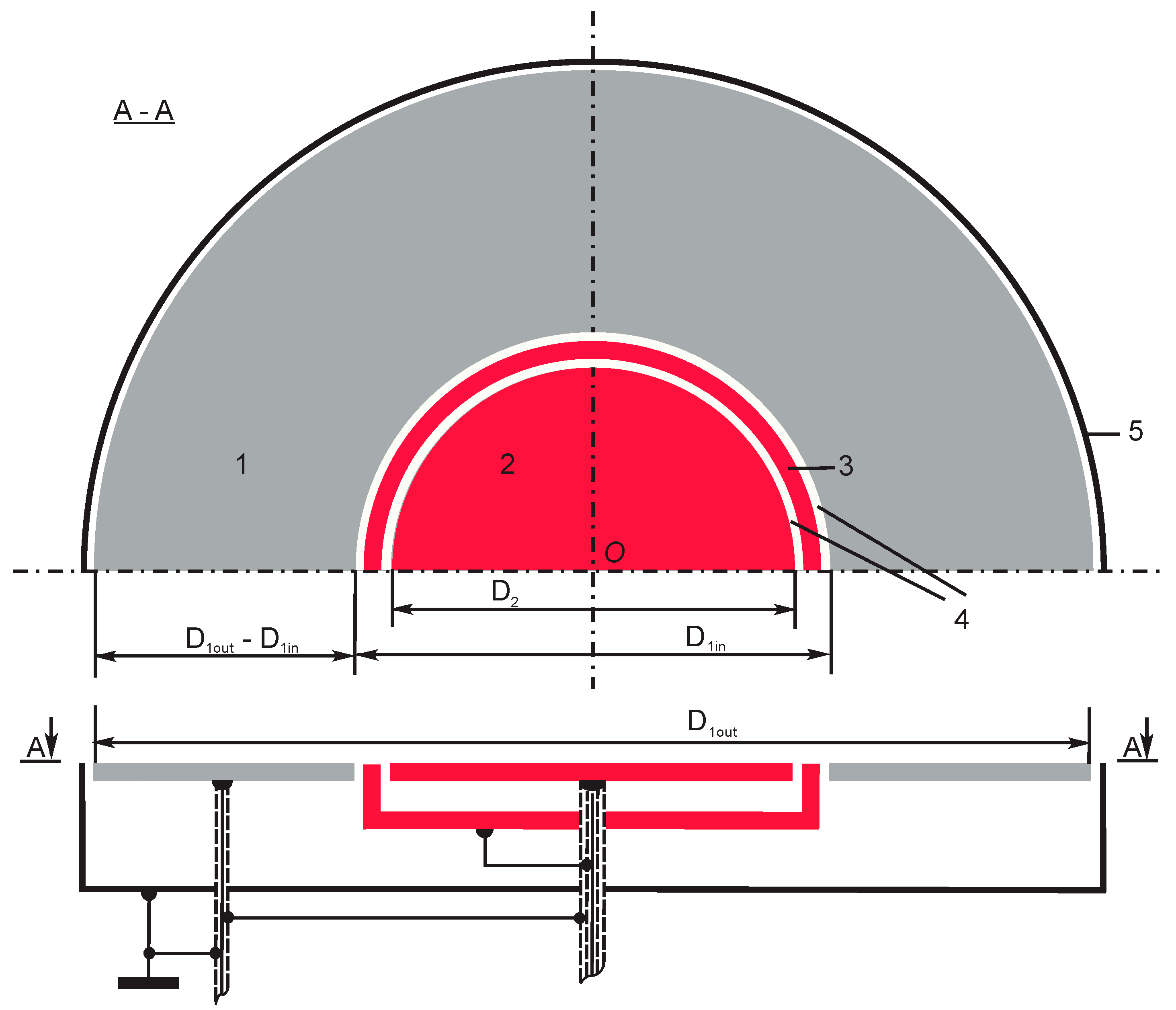
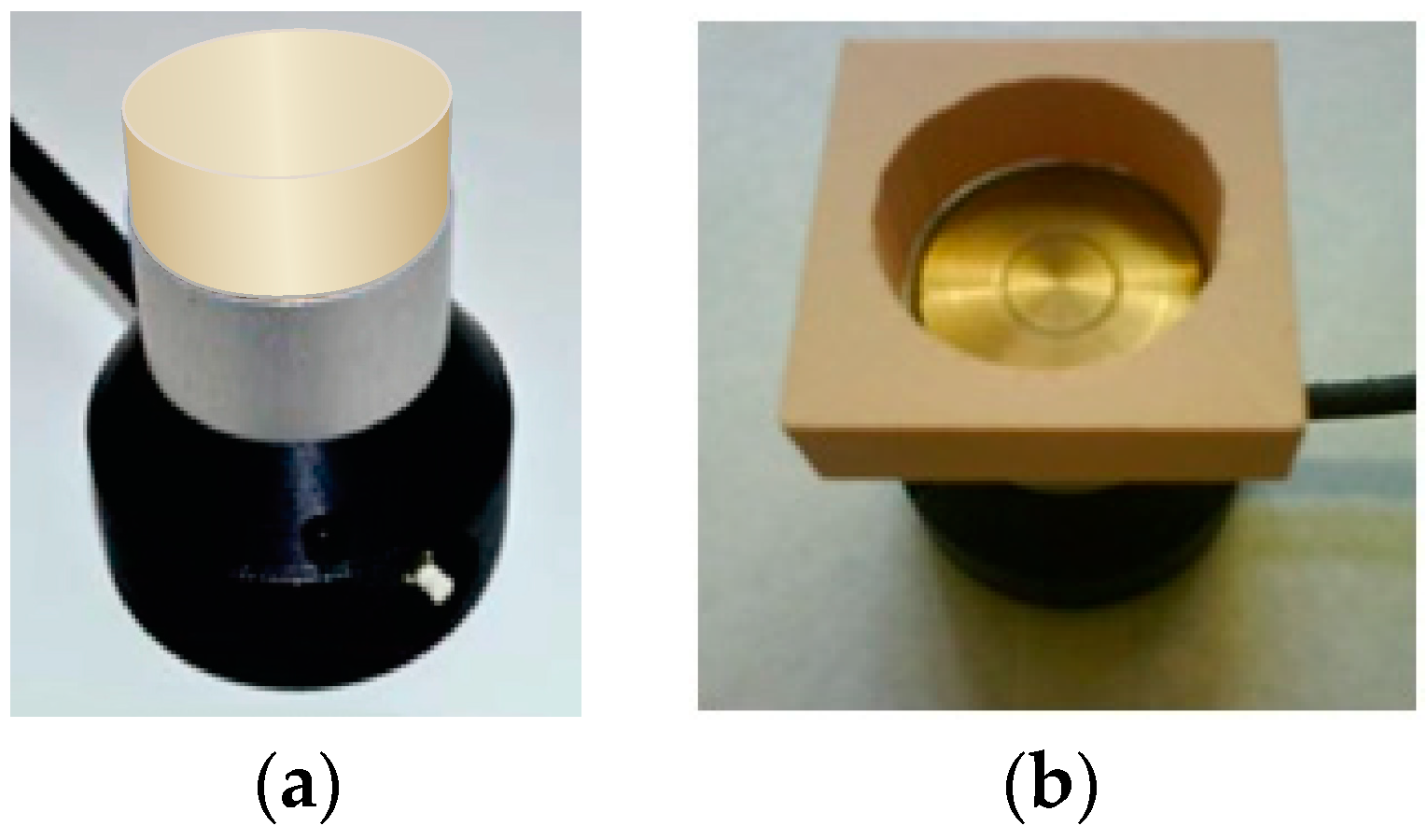
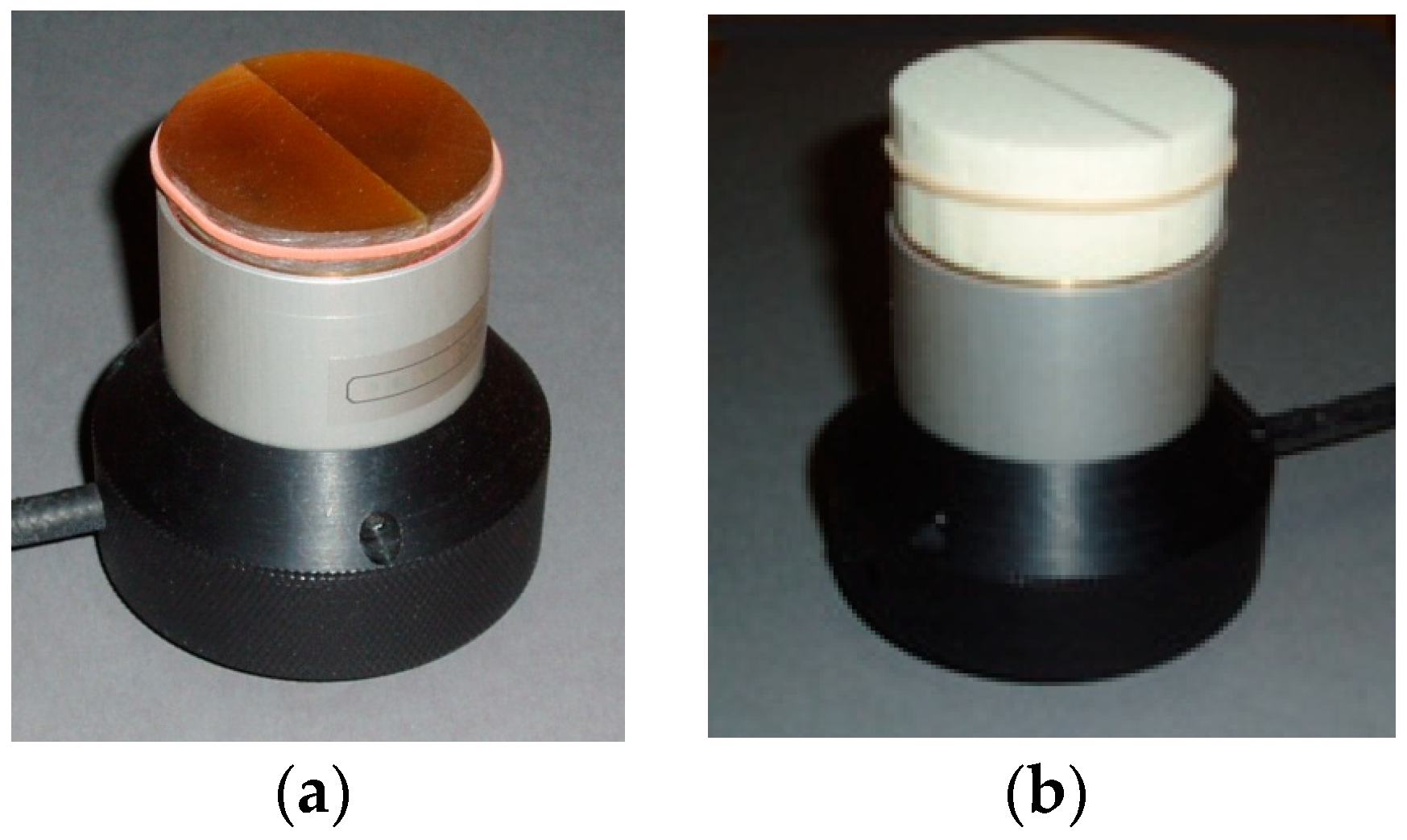
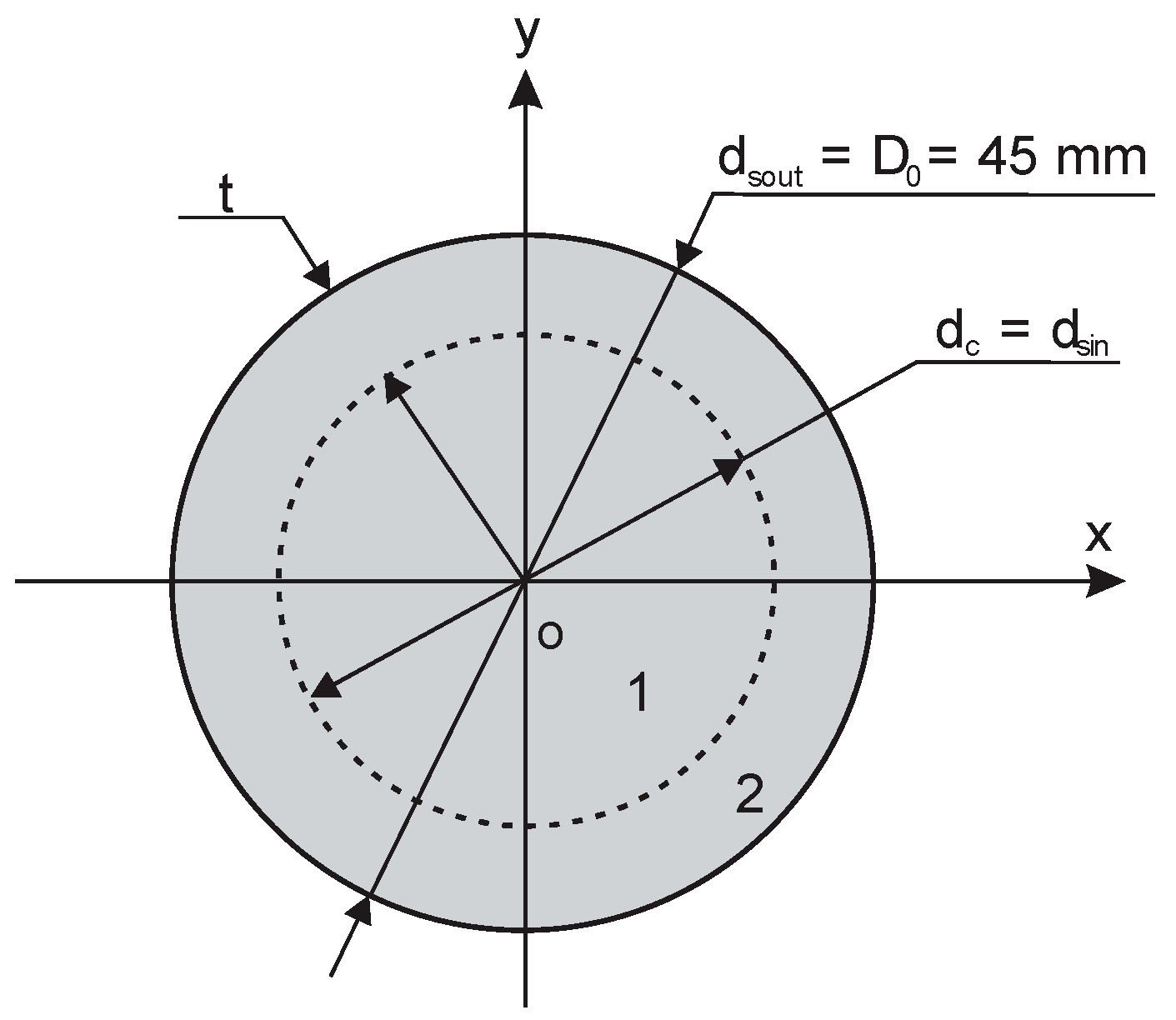
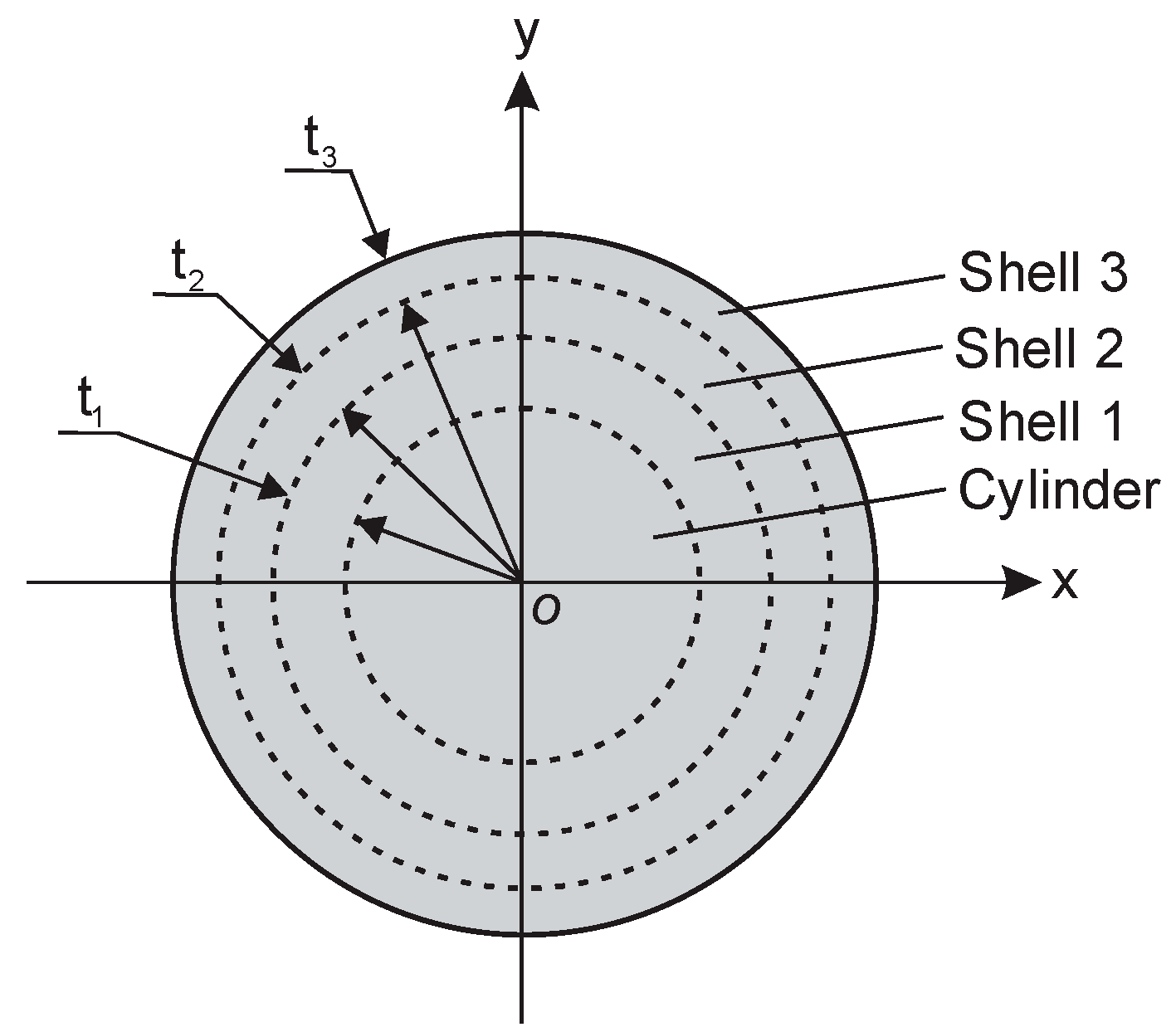
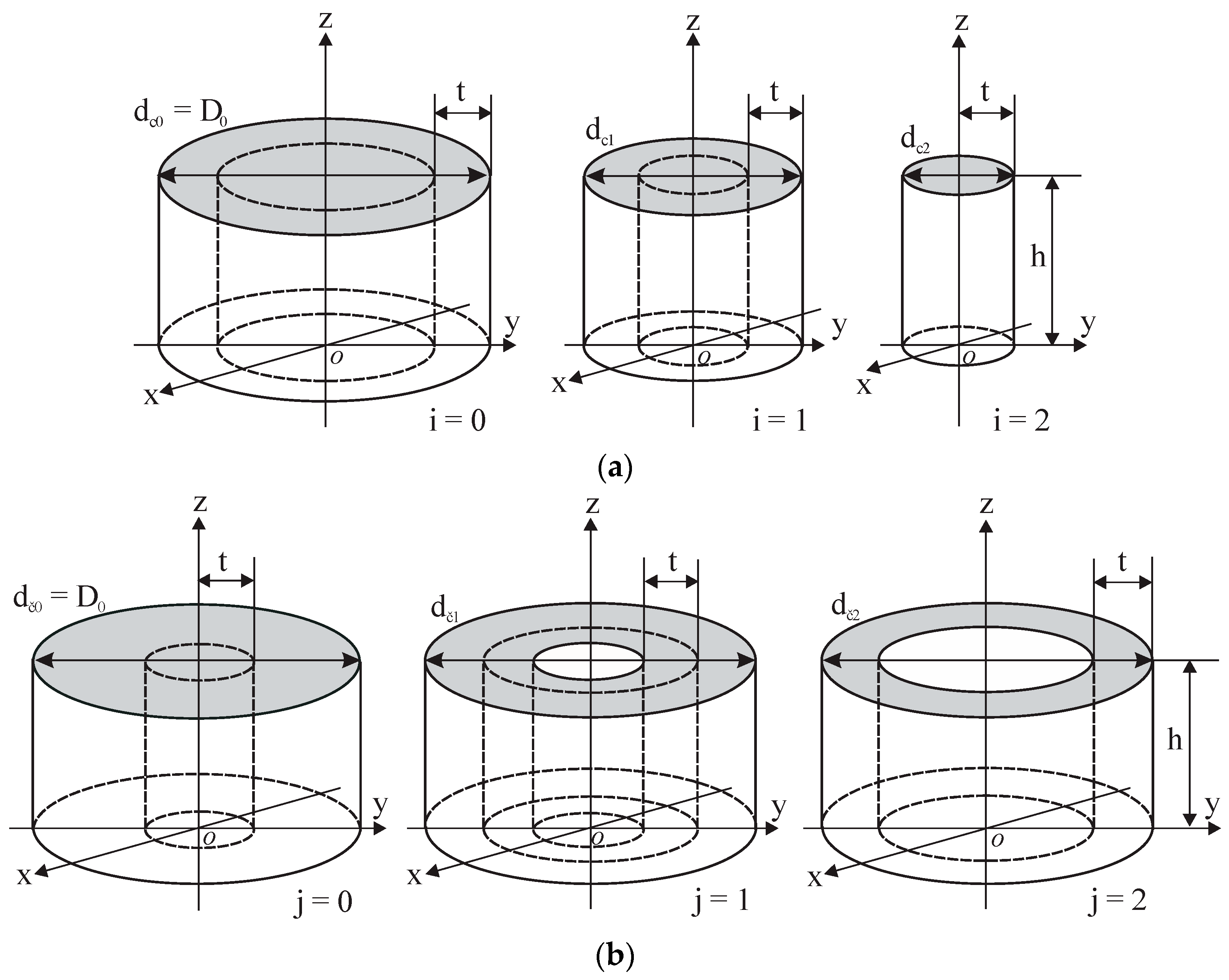
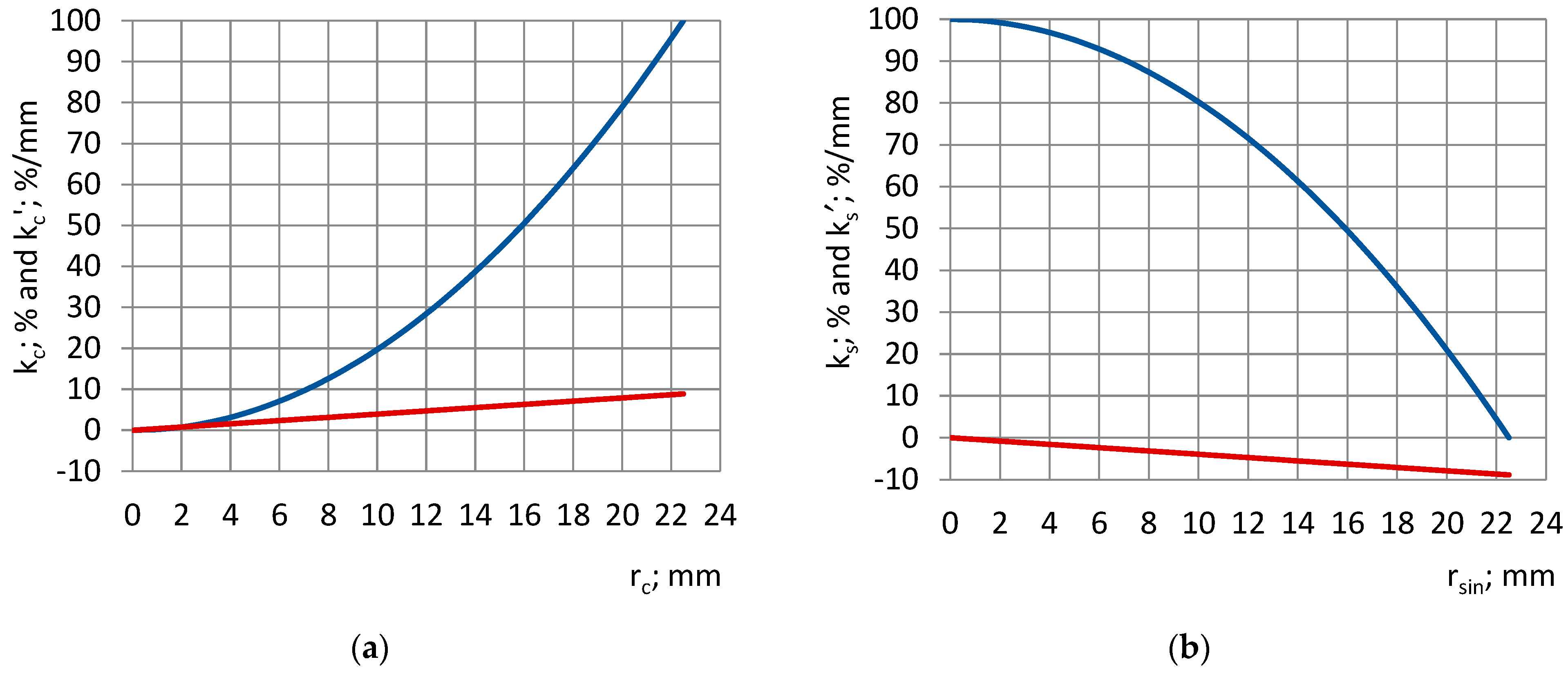




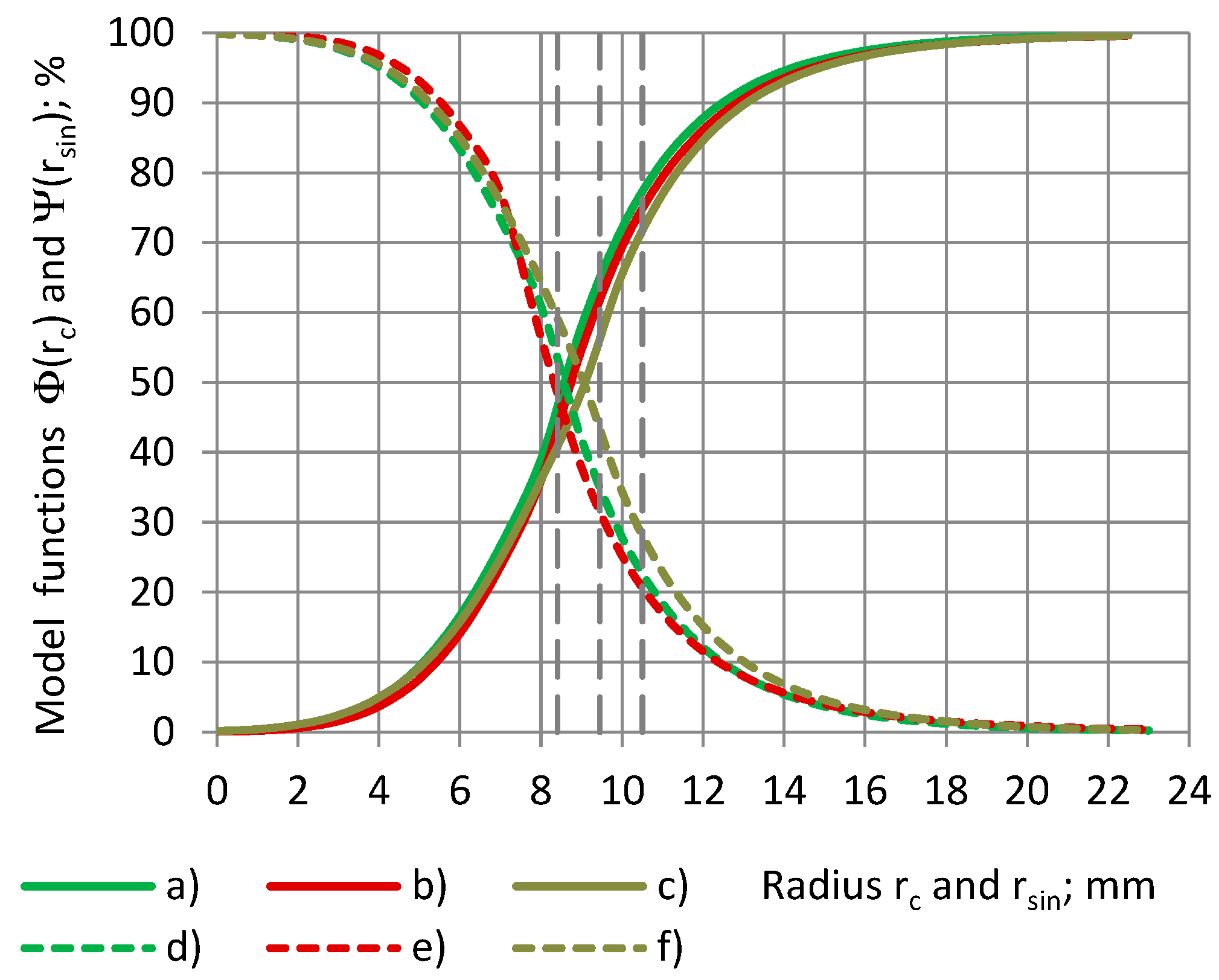
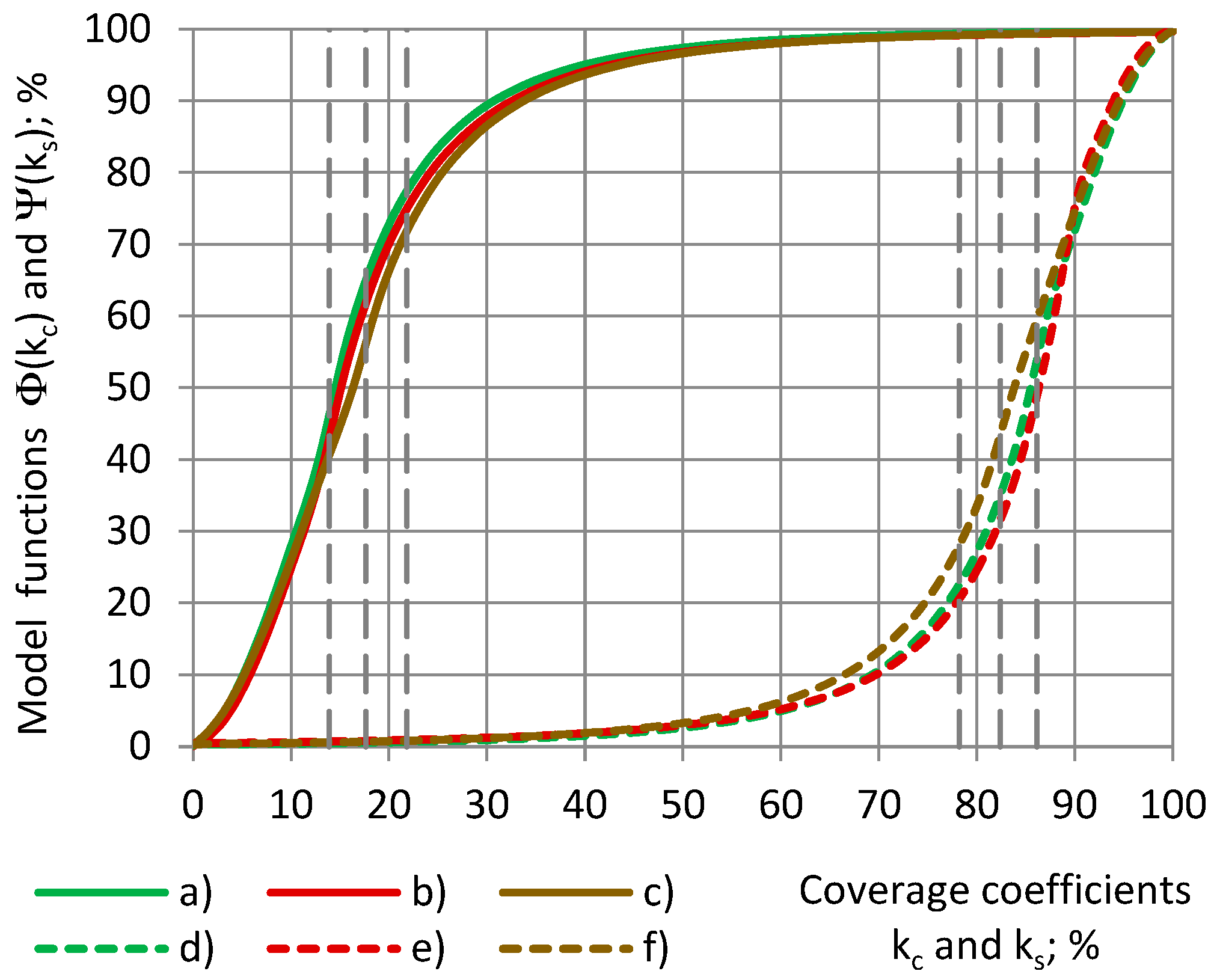
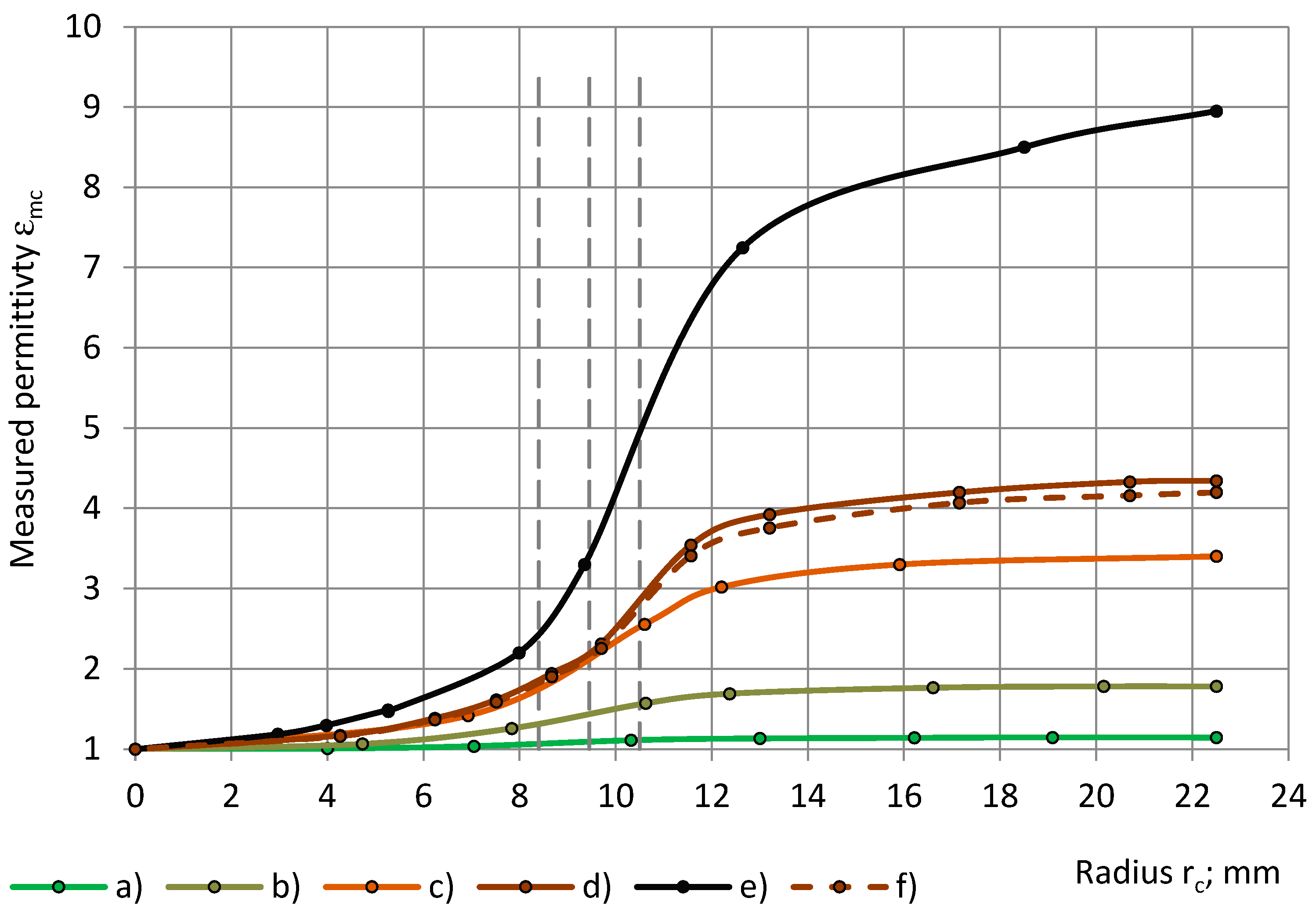
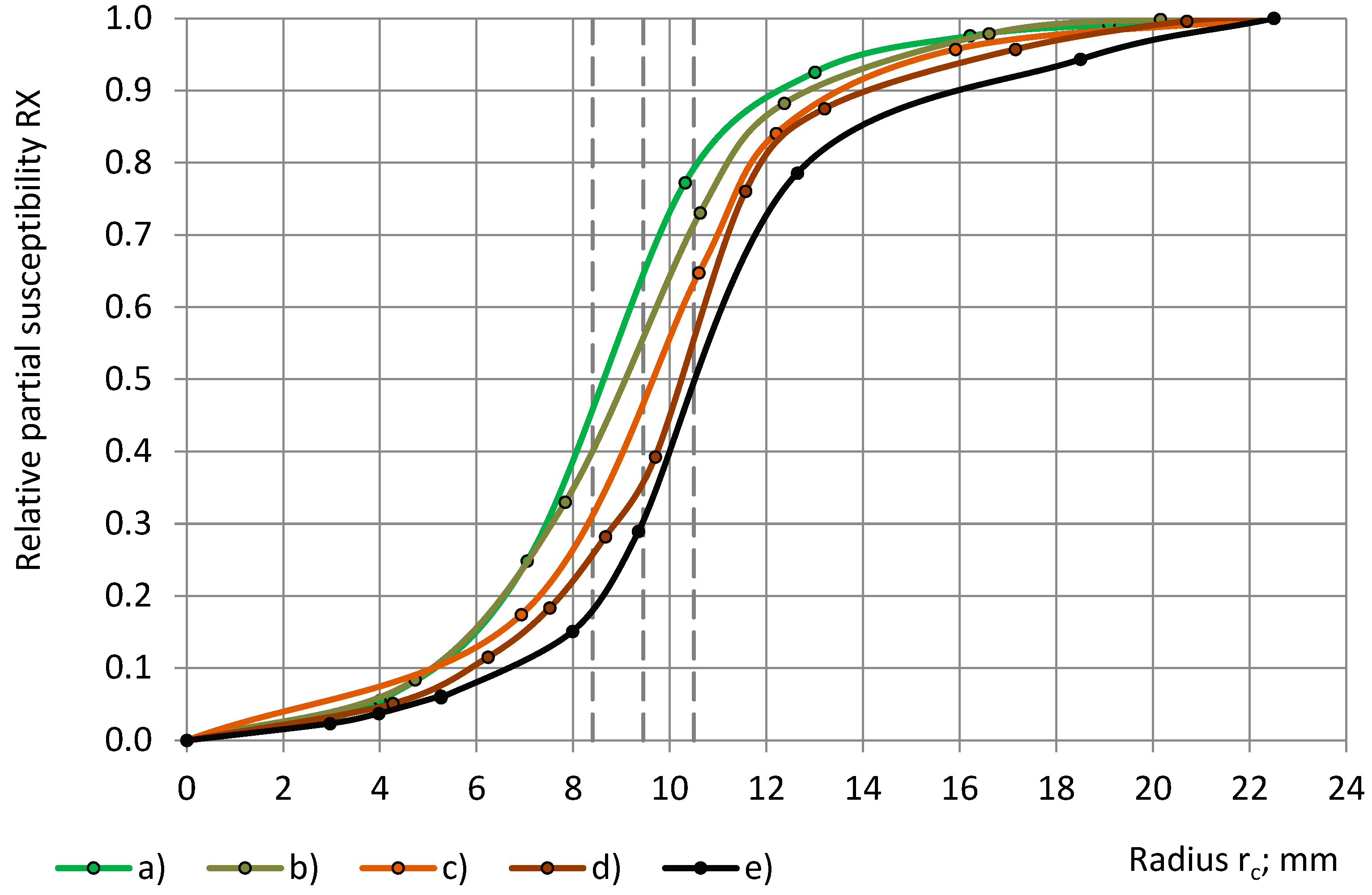



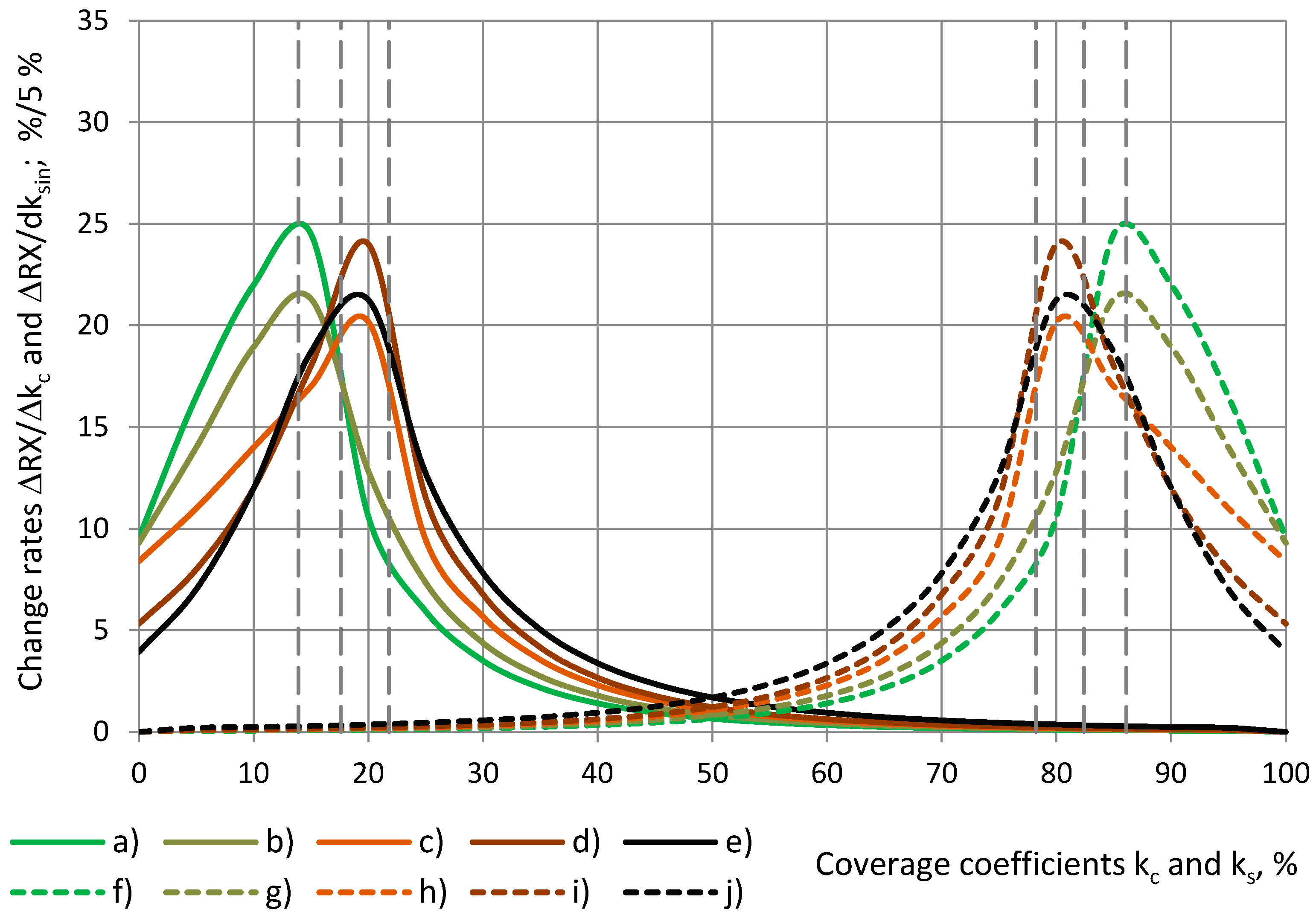
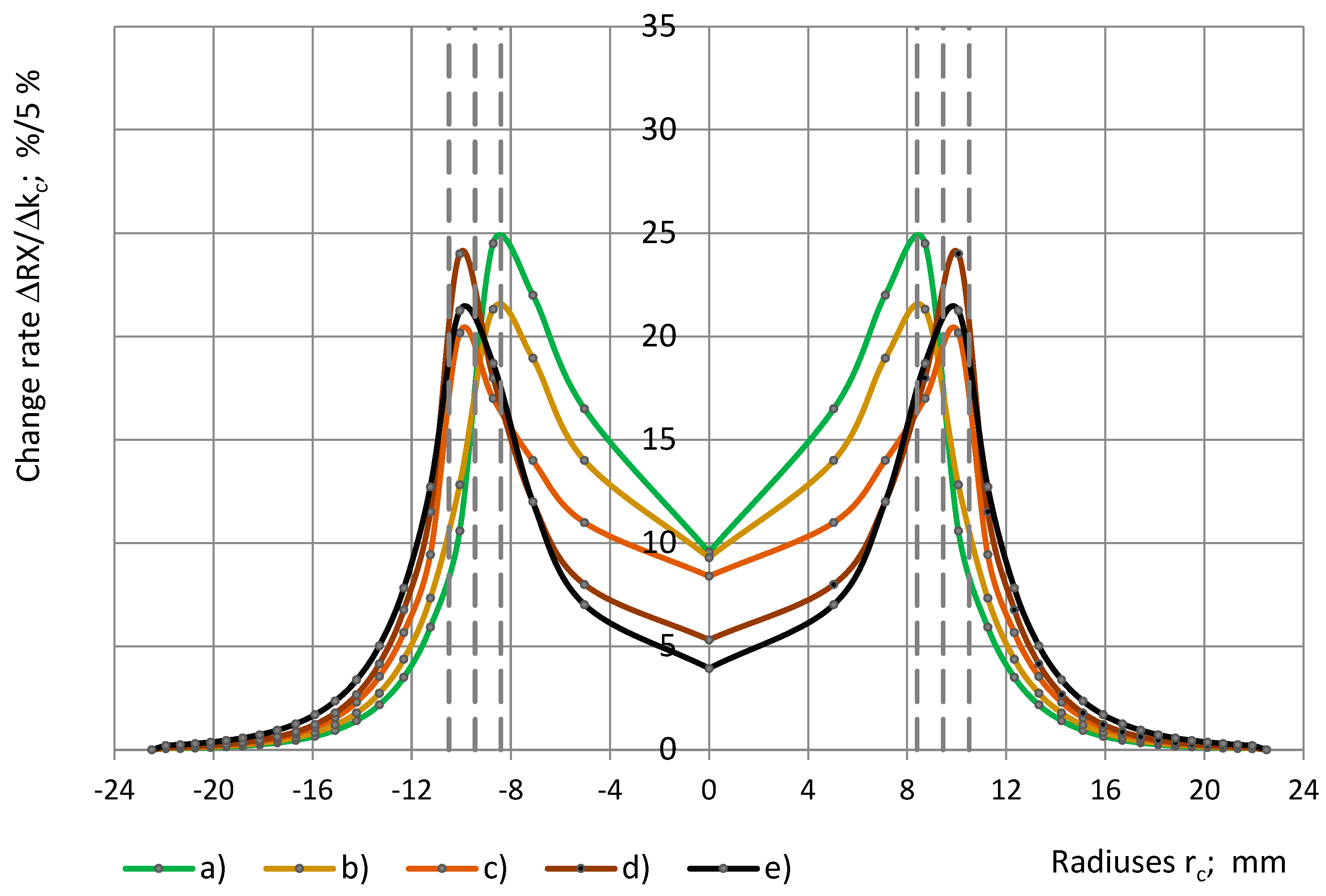
| i | Coverage Coefficient kc | Radius rc; mm | Increment Δrc; mm | i | Coverage Coefficient kc | Radius rc; mm | Increment Δrc; mm |
|---|---|---|---|---|---|---|---|
| 1 | 0.00 | 0.0 | 5.03 | 12 | 0.55 | 16.7 | 0.74 |
| 2 | 0.05 | 5.0 | 2.08 | 13 | 0.60 | 17.4 | 0.71 |
| 3 | 0.10 | 7.1 | 1.60 | 14 | 0.65 | 18.1 | 0.68 |
| 4 | 0.15 | 8.7 | 1.35 | 15 | 0.70 | 18.8 | 0.66 |
| 5 | 0.20 | 10.1 | 1.19 | 16 | 0.75 | 19.5 | 0.64 |
| 6 | 0.25 | 11.3 | 1.07 | 17 | 0.80 | 20.1 | 0.62 |
| 7 | 0.30 | 12.3 | 0.99 | 18 | 0.85 | 20.7 | 0.60 |
| 8 | 0.35 | 13.3 | 0.92 | 19 | 0.90 | 21.3 | 0.58 |
| 9 | 0.40 | 14.2 | 0.86 | 20 | 0.95 | 21.9 | 0.57 |
| 10 | 0.45 | 15.1 | 0.82 | 21 | 1.00 | 22.5 | 0.00 |
| 11 | 0.50 | 15.9 | 0.78 |
| N | Density ρ; kg/m3 | Kind of a Sample | Measured Permittivity εm | Expanded Uncertainty U95% | ||||
|---|---|---|---|---|---|---|---|---|
| f1 | f7 | f16 | f1 | f7 | f16 | |||
| 1 | 50 | (1) | 1.09 | 1.09 | 1.08 | 0.010 | 0.010 | 0.010 |
| (2) | 1.10 | 1.09 | 1.08 | 0.010 | 0.010 | 0.010 | ||
| (3) | 1.09 | 1.09 | 1.08 | 0.010 | 0.010 | 0.010 | ||
| 2 | 144 | (1) | 1.28 | 1.26 | 1.24 | 0.013 | 0.010 | 0.100 |
| (2) | 1.27 | 1.26 | 1.25 | 0.012 | 0.010 | 0.100 | ||
| (3) | 1.27 | 1.26 | 1.24 | 0.012 | 0.010 | 0.100 | ||
| 3 | 427 | (1) | 1.86 | 1.84 | 1.75 | 0.011 | 0.011 | 0.011 |
| (2) | 1.87 | 1.84 | 1.76 | 0.015 | 0.011 | 0.010 | ||
| (3) | 1.86 | 1.84 | 1.76 | 0.011 | 0.011 | 0.010 | ||
| N | Dielectric Material | Density ρ; kg/m3 | Sample | Thickness t; mm | Permittivity εt and εmc | ||
|---|---|---|---|---|---|---|---|
| f1 | f8 | f16 | |||||
| 1 | PU foam SikaBlock-M450 | 437 | A cylinder | 12 | 1.855 | 1.802 | 1.756 |
| 2 | Two semi-cylinders | 1.852 | 1.804 | 1.757 | |||
| |R|; % | 0.16 | 0.11 | 0.06 | ||||
| 3 | Monolithic PU SikaBlock- M960 | 1180 | A cylinder | 12 | 3.748 | 3.672 | 3.507 |
| 4 | Two semi-cylinders | 3.764 | 3.681 | 3.520 | |||
| |R|; % | 0.43 | 0.25 | 0.37 | ||||
| 5 | Monolithic PU, lab-made | 1280 | Two semi-cylinders | 12 | 3.474 | 3.408 | 3.310 |
| Sample/Subsample | Diameter | Thickness of a Shell Wall t; mm | Cross-Sectional Area S; mm2 | Coverage Coefficients kc and ks; % | |||
|---|---|---|---|---|---|---|---|
| d; mm | din; mm | dout; mm | |||||
| Cylinder, complete | 45.0 | - | - | - | 1590.4 | 100 | |
| Subsamples | |||||||
| Cylinder | 22.5 | 0.0 | 22.5 | - | 397.6 | 25 | |
| Shell 1 | - | 22.5 | 31.8 | 4.7 | 397.6 | 25 | |
| Shell 2 | - | 31.8 | 39.0 | 3.6 | 397.6 | 25 | |
| Shell 3 | - | 39.0 | 45.0 | 3.0 | 397.6 | 25 | |
| Sum: | 1590.4 | 100 | |||||
| The combined sample | |||||||
| Cylinder + shell 1 + shell 2 + shell 3 | 45.0 | - | - | 1590.4 | 100 | ||
| Sample/Subsample | Diameter | Thickness of a Shell Wall t; mm | Area S; mm2 | kc and ks; % | εt and εm(1 kHz) | Susceptibility χt and χp (1 kHz) | χp/Sumχp; % | ||
|---|---|---|---|---|---|---|---|---|---|
| d; mm | din; mm | dout; mm | |||||||
| Cylinder, complete | 44.9 | - | - | - | 1583.4 | 99.6 | 1.40 | 0.40 | |
| Subsamples | |||||||||
| Cylinder | 22.2 | - | - | - | 387.1 | 24.3 | 1.34 | 0.34 | 89.3 |
| Shell 1 | - | 22.8 | 31.5 | 4.35 | 371.0 | 23.3 | 1.03 | 0.03 | 8.1 |
| Shell 2 | - | 32.1 | 38.7 | 3.3 | 367.0 | 23.1 | 1.01 | 0.01 | 2.1 |
| Shell 3 | - | 39.1 | 44.9 | 2.9 | 382.6 | 24.1 | 1.00 | 0.00 | 0.5 |
| Sum: | 1507.7 | 94.8 | 4.38 | 0.38 | 100.0 | ||||
| The combined sample | |||||||||
| Cylinder + shell 1 + shell 2 + shell 3 | 44.9 | - | - | - | 1507.7 | 94.8 | 1.40 | 0.40 | 100.0 |
| Radius re1in; mm | Coverage Coefficients kc and ks; % | Radius re1out; mm | Coverage Coefficients kc and ks; % | Radius re2; mm | Coverage Coefficients kc and ks; % | Radius re3; mm | Coverage Coefficients kc and ks; % |
|---|---|---|---|---|---|---|---|
| 10.50 | 21.8 | 22.50 | 100.0 | 8.40 | 13.9 | 9.45 | 17.6 |
| 78.2 | 0.0 | 86.1 | 82.4 |
| N | PU Foams | Density ρ; kg/m3 | True Permitt. εt (1 kHz) | Model Functions Φ(rc) and Ψ(rsin) | |||||
|---|---|---|---|---|---|---|---|---|---|
| Normal Cumulative f1c(rc) or f1s(rsin) | Lognormal Cumulative f2c(rc) or f2s(rsin) | ||||||||
| μ1 | σ1 | Logical | μ2 | σ2 | rT | ||||
| Cylinders | |||||||||
| 1 | SikaBlock-M80 | 85 | 1.15 | 8.8 | 2.9 | TRUE | 1.32 | 0.56 | −4.8 |
| 2 | SikaBlock-M150 | 144 | 1.24 | 9.0 | 2.8 | ---“--- | 1.29 | 0.59 | −5.1 |
| 3 | SikaBlock-M450 | 415 | 1.78 | 9.1 | 3.1 | ---“--- | 1.32 | 0.57 | −5.3 |
| Shells | |||||||||
| 1 | SikaBlock-M80 | 85 | 1.15 | 8.8 | 2.9 | TRUE | 1.32 | 0.56 | −4.8 |
| 2 | SikaBlock-M150 | 144 | 1.24 | 9.0 | 2.7 | ---“--- | 1.10 | 0.67 | −5.3 |
| 3 | SikaBlock-M450 | 415 | 1.78 | 9.1 | 3.1 | ---“--- | 1.32 | 0.57 | −5.3 |
| N | Dielectric Material | Density; kg/m3 | Permitt. εt (1 kHz) | Model Function Φ(rc) | |||||
|---|---|---|---|---|---|---|---|---|---|
| Normal Cumulative f1(rc) | Lognormal Cumulative f2(rc) | ||||||||
| μ1 | σ1 | Logical | μ2 | σ2 | rT | ||||
| 1 | Monolithic PU; lab-made | 1280 | 3.40 | 9.8 | 3.5 | TRUE | 1.30 | 0.58 | −6.0 |
| 2 | Monolithic PU Sika M945 | 1352 | 4.34 | 10.8 | 3.6 | ---“--- | 1.15 | 0.63 | −7.0 |
| 3 | Epoxy LAB975 | 708 | 8.95 | 12.0 | 4.0 | ---“--- | 1.10 | 0.73 | −7.6 |
Disclaimer/Publisher’s Note: The statements, opinions and data contained in all publications are solely those of the individual author(s) and contributor(s) and not of MDPI and/or the editor(s). MDPI and/or the editor(s) disclaim responsibility for any injury to people or property resulting from any ideas, methods, instructions or products referred to in the content. |
© 2024 by the author. Licensee MDPI, Basel, Switzerland. This article is an open access article distributed under the terms and conditions of the Creative Commons Attribution (CC BY) license (https://creativecommons.org/licenses/by/4.0/).
Share and Cite
Beverte, I. Electric Susceptibility at Partial Coverage of a Circular One-Side Access Capacitive Sensor with Rigid Polyurethane Foams. Sensors 2024, 24, 3003. https://doi.org/10.3390/s24103003
Beverte I. Electric Susceptibility at Partial Coverage of a Circular One-Side Access Capacitive Sensor with Rigid Polyurethane Foams. Sensors. 2024; 24(10):3003. https://doi.org/10.3390/s24103003
Chicago/Turabian StyleBeverte, Ilze. 2024. "Electric Susceptibility at Partial Coverage of a Circular One-Side Access Capacitive Sensor with Rigid Polyurethane Foams" Sensors 24, no. 10: 3003. https://doi.org/10.3390/s24103003






